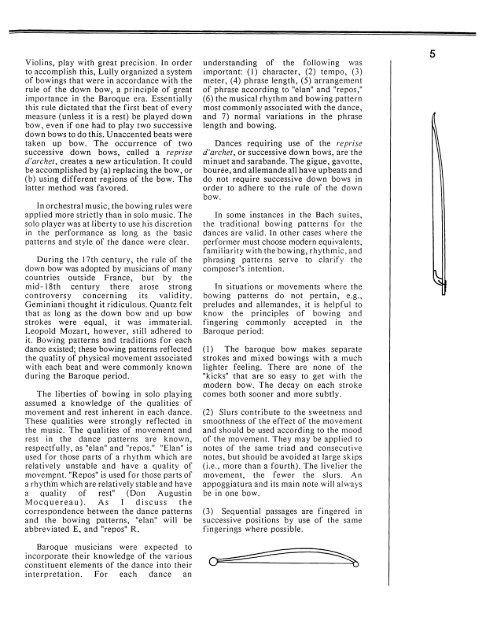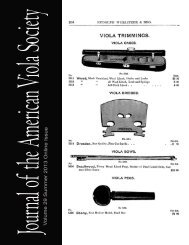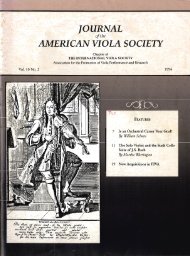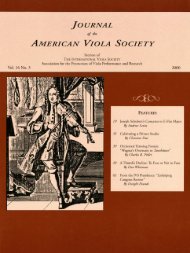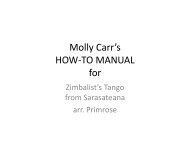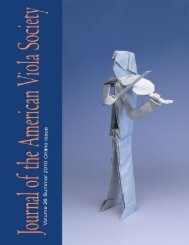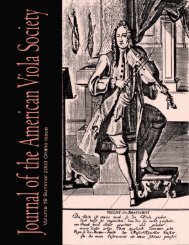Journal of the American Viola Society Volume 6 No. 3, Fall 1990
Journal of the American Viola Society Volume 6 No. 3, Fall 1990
Journal of the American Viola Society Volume 6 No. 3, Fall 1990
You also want an ePaper? Increase the reach of your titles
YUMPU automatically turns print PDFs into web optimized ePapers that Google loves.
Violins, play with great precision. In order<br />
to accomplish this, Lully organized a system<br />
<strong>of</strong> bowings that were in accordance with <strong>the</strong><br />
rule <strong>of</strong> <strong>the</strong> down bow, a principle <strong>of</strong> great<br />
importance in <strong>the</strong> Baroque era. Essentially<br />
this rule dictated that <strong>the</strong> first beat <strong>of</strong> every<br />
measure (unless it is a rest) be played down<br />
bow, even if one had to play two successive<br />
down bows to do this. Unaccented beats were<br />
taken up bow. The occurrence <strong>of</strong> two<br />
successive down bows, called a reprise<br />
d'archei, creates a new articulation. It could<br />
be accomplished by (a) replacing <strong>the</strong> bow, or<br />
(b) using different regions <strong>of</strong> <strong>the</strong> bow. The<br />
latter method was favored.<br />
In orchestral music, <strong>the</strong> bowing rules were<br />
applied more strictly than in solo music. The<br />
solo player was at liberty to use his discretion<br />
in <strong>the</strong> performance as long as <strong>the</strong> basic<br />
patterns and style <strong>of</strong> <strong>the</strong> dance were clear.<br />
During <strong>the</strong> 17th century, <strong>the</strong> rule <strong>of</strong> <strong>the</strong><br />
down bow was adopted by musicians <strong>of</strong> many<br />
countries outside France, but by <strong>the</strong><br />
mid-TBth century <strong>the</strong>re arose strong<br />
controversy concerning its validity.<br />
Geminiani thought it ridiculous. Quantz felt<br />
that as long as <strong>the</strong> down bow and up bow<br />
strokes were equal, it was immaterial.<br />
Leopold Mozart, however, still adhered to<br />
it. Bowing patterns and traditions for each<br />
dance existed; <strong>the</strong>se bowing patterns reflected<br />
<strong>the</strong> quality <strong>of</strong> physical movement associated<br />
with each beat and were commonly known<br />
during <strong>the</strong> Baroque period.<br />
The liberties <strong>of</strong> bowing in solo playing<br />
assumed a knowledge <strong>of</strong> <strong>the</strong> qualities <strong>of</strong><br />
movement and rest inherent in each dance.<br />
These qualities were strongly reflected in<br />
<strong>the</strong> music. The qualities <strong>of</strong> movement and<br />
rest in <strong>the</strong> dance patterns are known,<br />
respectfully, as "elan" and "repos." "Elan" is<br />
used for those parts <strong>of</strong> a rhythm which are<br />
relatively unstable and have a quality <strong>of</strong><br />
movement. "Repos" is used for those parts <strong>of</strong><br />
a rhythm which are relatively stable and have<br />
a quality <strong>of</strong> rest" (Don Augustin<br />
Mocquereau). As I discuss <strong>the</strong><br />
correspondence between <strong>the</strong> dance patterns<br />
and <strong>the</strong> bowing patterns, "elan" will be<br />
abbreviated E, and "repos" R.<br />
Baroque musicians were expected to<br />
incorporate <strong>the</strong>ir knowledge <strong>of</strong> <strong>the</strong> various<br />
constituent elements <strong>of</strong> <strong>the</strong> dance into <strong>the</strong>ir<br />
interpretation. For each dance an<br />
understanding <strong>of</strong> <strong>the</strong> following was<br />
important: (1) character, (2) tempo, (3)<br />
meter, (4) phrase length, (5) arrangement<br />
<strong>of</strong> phrase according to "elan" and "repos,"<br />
(6) <strong>the</strong> musical rhythm and bowing pattern<br />
most commonly associated with <strong>the</strong> dance,<br />
and 7) normal variations in <strong>the</strong> phrase<br />
length and bowing.<br />
Dances requiring use <strong>of</strong> <strong>the</strong> reprise<br />
d'archet, or successive down bows, are <strong>the</strong><br />
minuet and sarabande. The gigue, gavotte,<br />
bouree, and allemande all have upbeats and<br />
do not require successive down bows in<br />
order to adhere to <strong>the</strong> rule <strong>of</strong> <strong>the</strong> down<br />
bow.<br />
In some instances in <strong>the</strong> Bach suites,<br />
<strong>the</strong> traditional bowing patterns for <strong>the</strong><br />
dances are valid. In o<strong>the</strong>r cases where <strong>the</strong><br />
performer must choose modern equivalents,<br />
familiarity with <strong>the</strong> bowing, rhythmic, and<br />
phrasing patterns serve to clarify <strong>the</strong><br />
composer's intention.<br />
In situations or movements where <strong>the</strong><br />
bowing patterns do not pertain, e.g.,<br />
preludes and allemandes, it is helpful to<br />
know <strong>the</strong> principles <strong>of</strong> bowing and<br />
fingering commonly accepted in <strong>the</strong><br />
Baroque period:<br />
(1) The baroque bow makes separate<br />
strokes and mixed bowings with a much<br />
lighter feeling. There are none <strong>of</strong> <strong>the</strong><br />
"kicks" that are so easy to get with <strong>the</strong><br />
modern bow. The decay on each stroke<br />
comes both sooner and more subtly.<br />
(2) Slurs contribute to <strong>the</strong> sweetness and<br />
smoothness <strong>of</strong> <strong>the</strong> effect <strong>of</strong> <strong>the</strong> movement<br />
and should be used according to <strong>the</strong> mood<br />
<strong>of</strong> <strong>the</strong> movement. They may be applied to<br />
notes <strong>of</strong> <strong>the</strong> same triad and consecutive<br />
notes, but should be avoided at large skips<br />
(i.e., more than a fourth). The livelier <strong>the</strong><br />
movement, <strong>the</strong> fewer <strong>the</strong> slurs. An<br />
appoggiatura and its main note will always<br />
be in one bow.<br />
(3) Sequential passages are fingered in<br />
successive positions by use <strong>of</strong> <strong>the</strong> same<br />
fingerings where possible.<br />
5


